The Shroud and Imago Pietatis
Karolina Aszyk-Treppa ![]()
University of Gdansk, Poland
Zbigniew Treppa ![]()
University of Gdansk, Poland
At the end of the 1970s, the American sindonologist John P. Jackson posited that the Shroud of Turin clearly influenced the origin of many representations of Christ, especially those deriving from the Imago Pietatis canon (Latin for image of graciousness, kindness; in English: Man of Sorrows or Christ of Pity). In the 1930s, researchers began to investigate the sources of this canon, using Erwin Panofsky’s method of iconological analysis and inquiring into the role of the image in the passion rites of the Byzantine liturgy. In the latter field, Romuald Bauerris distinguished himself by confirming that this canon originated in the Eastern liturgy. On the basis of an analysis of Byzantine liturgical rituals, R. Bauerris concluded that the original representations of the Imago Pietatis canon were not of a Passionist nature. Tadeusz Dobrzeniecki, on the other hand, continuing the thought of the aforementioned researcher, concluded that the early representations of this canon emphasised victory over suffering rather than suffering itself, and were exclusively Eucharistic in character from the beginning (Dobrzeniecki 1971, p. 69). Other scholars believe that this canon developed in the 8th century from Byzantine epitaph imagery (G. Schiller).
Many art historians, citing the work of G. Shiller, believe that images of Christ executed according to the Imago Pietatis canon began to spread in the Western Church from the 13th century onwards. This involved the inclusion in worship of a small-scale mosaic made according to the principles of this canon, which was worshipped in the Basilica of the Holy Cross of Jerusalem (Santa Croce in Gerusalemme) in Rome. Some scholars speculate that it was supposed to be a copy of an earlier Byzantine image. Hans Belting has criticised this position, claiming that this mosaic was created in Constantinople at the beginning of the 14th century and moved to Italy around 1380. Most scholars, however, are in no doubt that the Imago Pietatis representation from Santa Croce in Gerusalemme began the Western tradition of this canon of imagery.
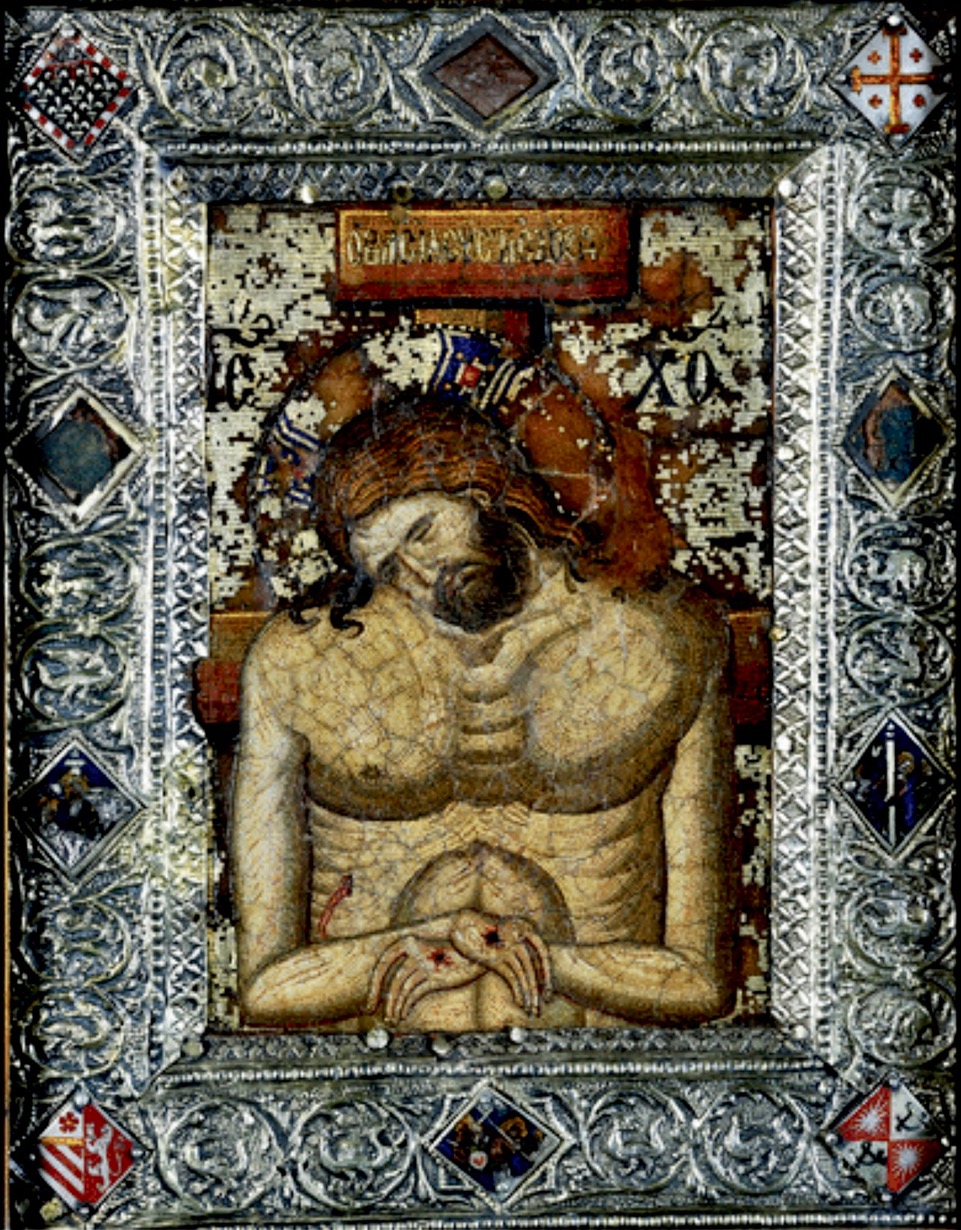
The canonical feature of the Imago Pietatis depictions is to show the half-figure of the exposed Saviour in a frontal position with eyes closed and head tilted, with wounds on his hands and with his side pierced. Christ’s wounds are depicted in different ways: in some depictions they are marked slightly (e.g. Niccolo di Tommaso’s painitngs from 1370 or those of Lorenzo Monaco from 1415–1417), but in most they are naturalistic (e.g. in those of Antonio Vivarini from 1450–1480 and Diego de la Cruz from 1482–1500).
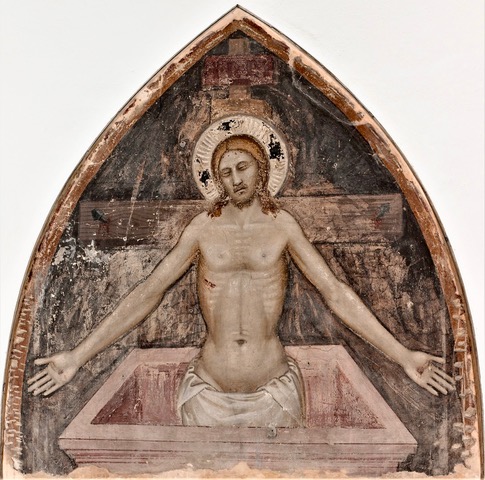
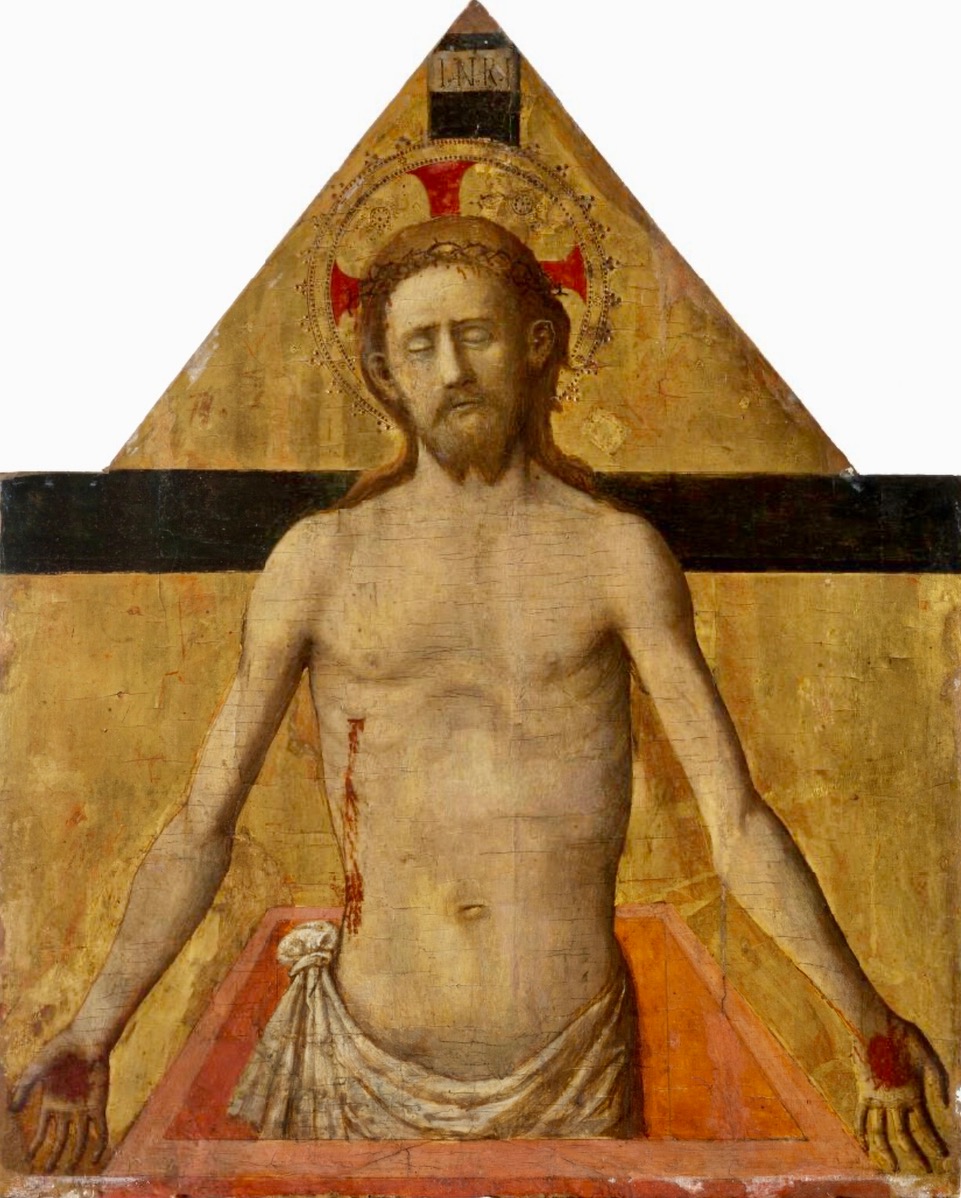
Most paintings of this canon feature a cross behind the figure of Christ. Imago Pietatis paintings usually show the figure of the Saviour in a somewhat hieratic manner, whose lower part of the underbelly is obscured in the edge of the sarcophagus situated in the foreground (e.g. in the painting by Taddea Gaddi from 1350–1366, Jacobello del Bonomo from 1385 or Carlo Civelli from 1468) or is adjacent to the lower edge of the picture frame (e.g. in the painting by Pietro Lorenzetti from 1340–1345, Giovanni Santi from 1490 and Hans Memling after 1490). Most minimalist depictions only present the body, sometimes confined to the bust, with the hands bent at the elbows at right angles (e.g. Pietro da Rimini’s depictions from 1320–1325 or Israhel van Meckenem’s from 1490).
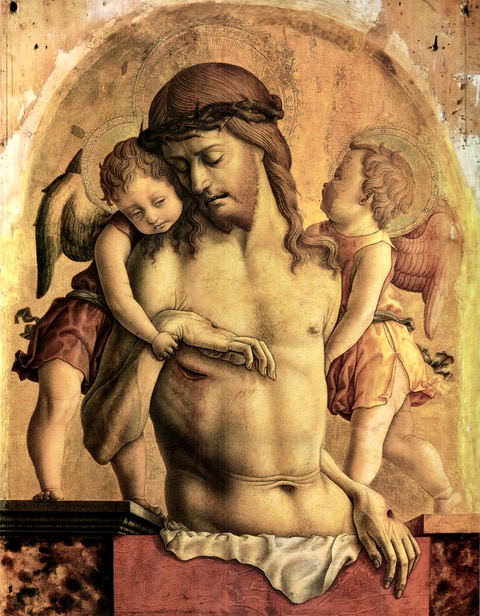
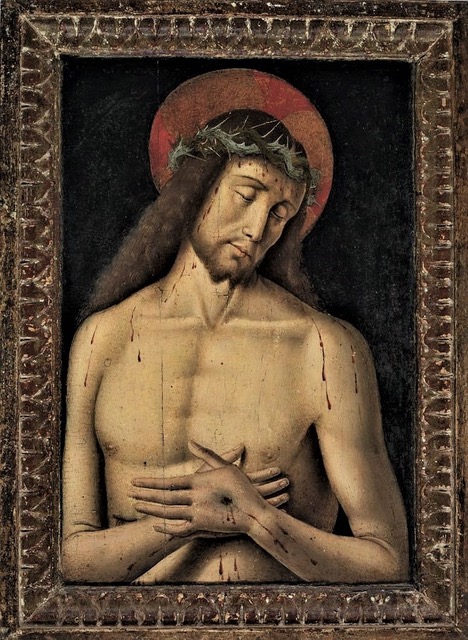
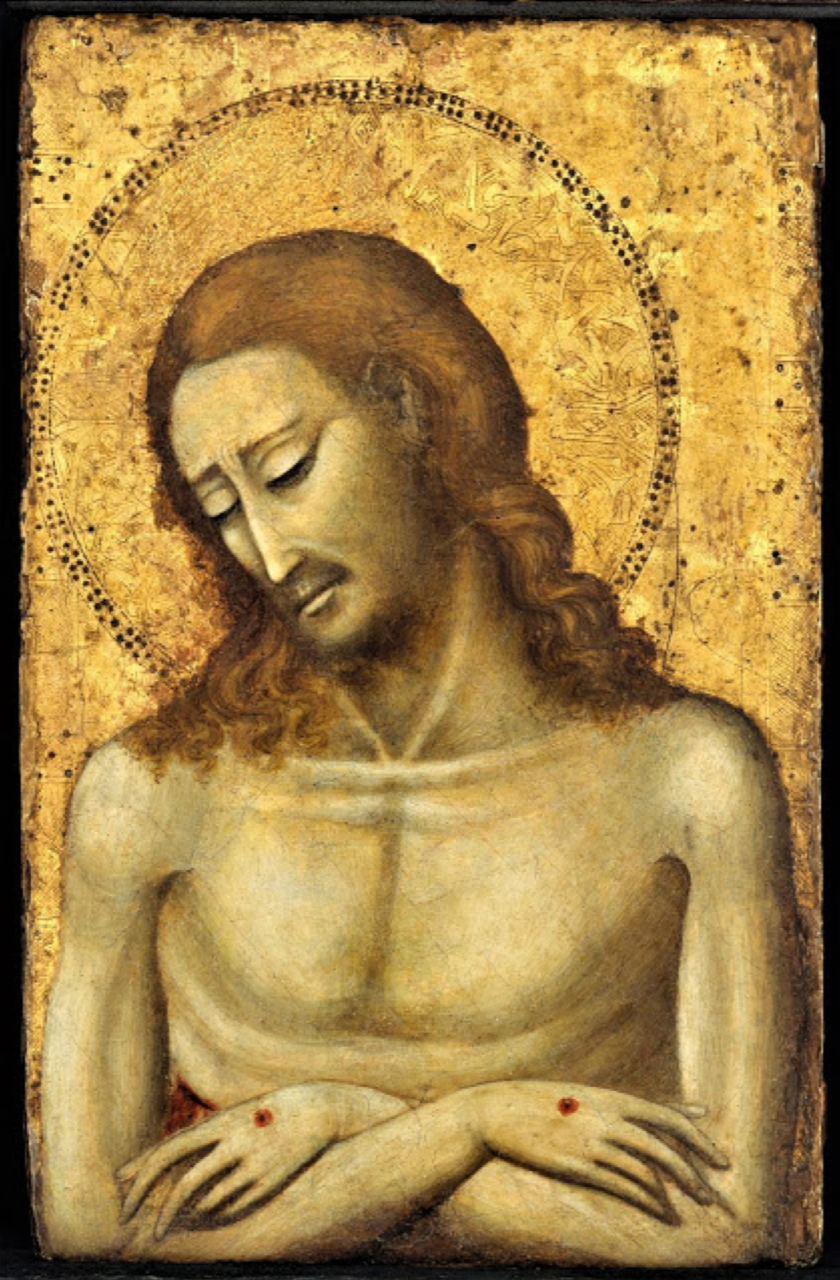
All the early images painted according to the canon show the figure of Christ with his arms crossed over his chest or falling on his lower abdomen. Later compositions show increasingly free interpretations of the body arrangement. Quattrocento artists (15th century) inspired each other in their search for new body arrangements, different from earlier forms of the canon; even such a prominent representative of the period as Sandro Boticelli joined the quest for new ways of depicting Christ. The imagination of the artists was not limited by anything, so that—in comparison—even the later icons of the Eastern Church make an impression of visual Christian orthodoxy. We have in mind artists of many Byzantine schools, who retain all the characteristic features of the oldest canon designs (e.g. the paintings of Nikolaos Tzaofuris from 1475–1500 and other representatives of the Cretan School after 1500).
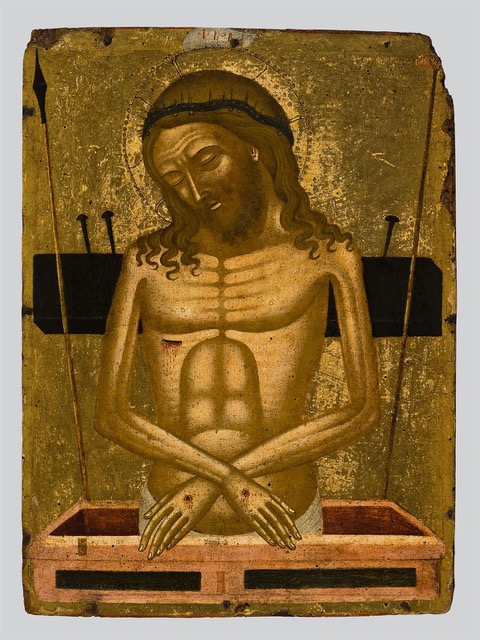

In the following centuries, the Canon Imago Pietatis was enriched by the introduction of the figure of the Mother of God into the paintings. Such images arose earliest in Byzantium in the 13th century, and were then also adopted in Kievan Rus and the rest of later Russia, where Christianity would spread. Everywhere there, icons contained the inscription: “Do not despair of me, Mother,” and this tradition was nurtured in the following centuries. The same was true in the Byzantine schools, where the motif of the Mother of God mourning for her Son was also reproduced on fabrics used in various forms in the liturgy. As the practice was cultivated in the following centuries, it did not disappear in Eastern Christianity: it took on various forms that were alluded to in the Gospel accounts of the burial of Jesus Christ. A close variant of representations of the type “Do not despair of me Mother,” are those showing on either side of the Saviour the figures of other saints, e.g. John the Baptist and Longinus the Centurion (e.g. painting by Nikolaos Tzaofuris from 1489–1493), which in turn come close to the canon of Lamentations, particularly prevalent in Byzantium and in the miniature paintings of Armenia (e.g. representations by Zachariah Aghtamartsi from 1377, Sargis Pidzak from 1320, or a full century earlier by Toros Roslin).
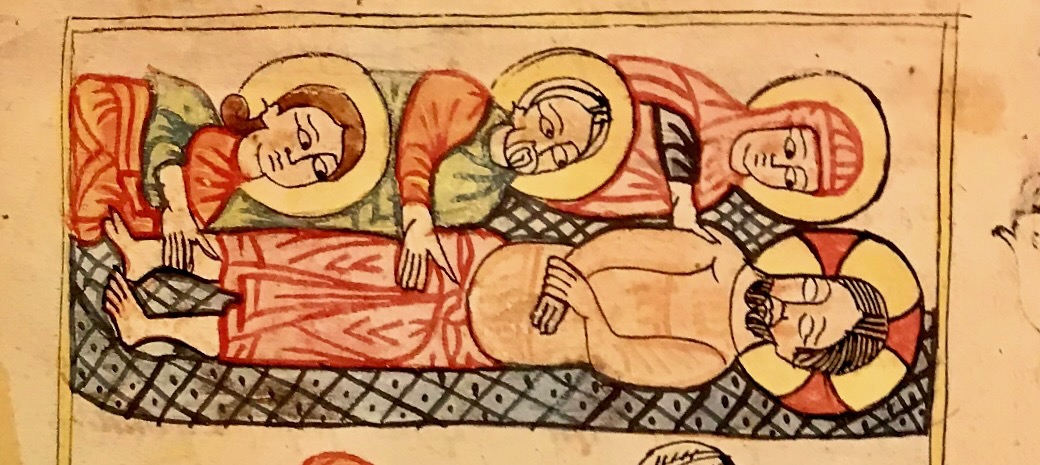
The canon Imago Pietatis was also combined with the convention of the mandylion. In this type of composition (e.g. in a well-known icon by an unknown author of the Moscow School from 1570), the canon form of the Imago Pietatis is situated in the lower part of the image, while the mandylion form is situated in the upper part.
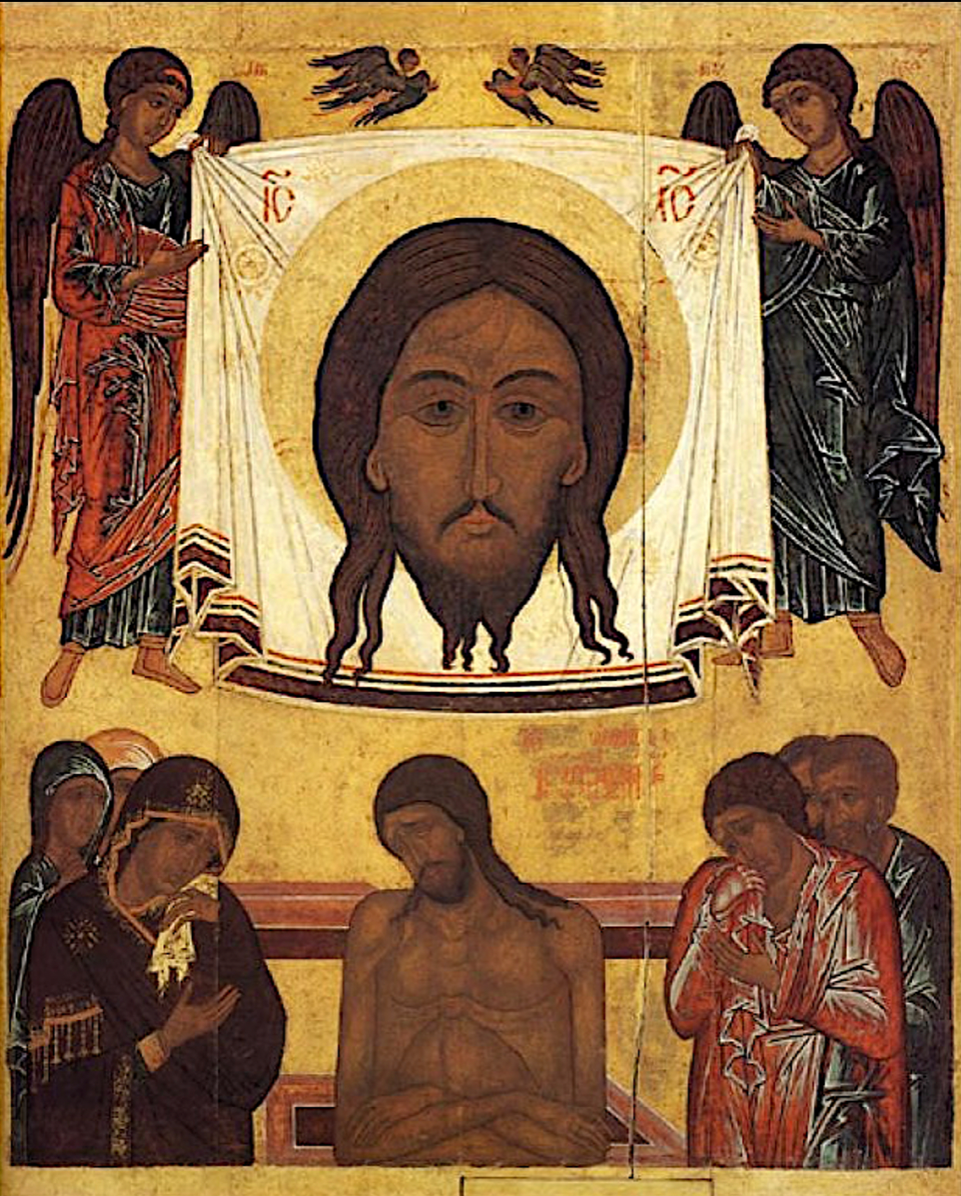
In combining the two conventions in one painting, two traditions of depicting images of Christ met. One was inspired by the depiction with closed eyes from the Shroud of Turin, as evidenced by the positioning of the figures imitating the way in which the layout of the body on the Shroud was reproduced (the arrangement of the hands from the Imago Pietatis depictions imitates the arrangement of the hands from the Shroud); the other was inspired by the image from the →Veil of Manoppello, as evidenced by the clear references in many mandylions to anatomical arrangements and facial expressions from the Veil image that were not observable from an analysis of the Shroud image (cf. →The Shroud and the Convention of the Mandylion).
In a theological sense, there is a close connection between the canon of the Lamentation (otherwise also referred to as the Lamentation or the Entombment) and the Shroud of Christ, which was reflected in Byzantine liturgical practice. These are contained in the liturgical object called epitaphios (Old Church Slavonic: плащаница, Old Greek: ἐπιτάφιος), which symbolises the Shroud of Christ during the Paschal liturgy. It is an embroidered cloth or picture painted on linen with a representation of Christ’s body resting in the tomb, which is sometimes reflected in the same position as Christ’s body on the Shroud of Turin (→The Epitaphios).
On Good Friday and Holy Saturday, the priest carries the epitaphios in procession over his head and deposits it in the altar area, then carries it to a place where the faithful can kiss and adore it. A number of surviving Byzantine epitaphioses dating from 1300–1600 (e.g. c. 1300 from Thessalonica; 14th century from the monastery of Pantocrator on Mount Athos; 14th–15th century from the monastery of Stavronikita on Mount Athos) show the positioning of Christ’s hands as in the negative image from the Shroud of Turin, where the right hand rests on the left.

The positioning of the hands, characteristic of the depictions described above, is also one of the most significant features of the Imago Pietatis canon depictions from the period between the 14th and 15th centuries. This is how Christ’s hands were depicted by icon makers of the Byzantine circle, Crete and Kievan Rus, as well as by early Renaissance painters in Italy. Based, among other things, on his observation of the described arrangement of the hands of the Imago Pietatis canon, John P. Jackson concluded that the canon must have drawn on a particular public presentation of the Shroud between 944 and 1204, when it was kept in Constantinople. This researcher’s theory is generally accepted in the sindonological community as highly credible.
In support of his thesis, J.P. Jackson cited the results of his observations of the fold marks in the fabric, which, in his opinion, have been created and preserved until our times, due to the fact that the Byzantines repeatedly pulled the Shroud out of a specially constructed container equipped with a system of rollers which enabled the fragments of the linen to move smoothly in up and down directions. This method of displaying the Shroud made it possible, in Jackson’s opinion, to expose that area of the body from the Shroud which is roughly reflected in the representations of the Imago Pietatis canon. The American sindonologist inferred that the icon painters who saw the image from the Shroud in Constantinople remembered it in this form and attempted to reproduce it in this way.
Both the Imago Pietatis canon and its variations (Do not despair after me, Mother; the Entombment; the Lamentations or the forms of epitaphs) evolved in different directions in terms of the development of forms and theological interpretation. In Western sacred art, the canon has almost completely disappeared, while it is still used in its classical form today in Orthodoxy. There are exceptions, however, when it is also used today by the creators of contemporary sacred paintings in the Catholic Church. One of the most valuable representations, which uses modern form while preserving the spiritual character of the subject, may be the painting referring to the form of epitaphios, and thus to the Shroud of Christ from Turin, by Jerzy Nowosielski, serving as the 14th Station of the Cross in the parish church in the Azory residential area in Krakow from 1977 (?) and in the parish church in Warsaw-Wesoła from 1979.
References
Bułgakow S., Ikona i kult ikony. Zarys dogmatyczny, przekł. i oprac. H. Paprocki, Bydgoszcz 2002.
Bułgakow S., Prawosławie. Zarys nauki Kościoła prawosławnego, przeł. H. Paprocki, Białystok–Warszawa 1992.
Charkiewicz J., Jezus Chrystus w ikonografii, Warszawa 2008.
Dobrzeniecki T., Niektóre zagadnienia ikonografii Męża Boleści, “Rocznik Muzeum Narodowego w Warszawie” 1971, No. 15, pp. 7–220.
Florenski P., Ikonostas i inne szkice, przeł. i przypisami opatrzył Z. Podgórzec, Białystok 1997.
Janocha M., Ikony w Polsce. Od średniowiecza do współczesności, Warszawa 2008.
Jurkowlaniec G., Chrystus Umęczony. Ikonografia w Polsce od XIII do XVI wieku, Warszawa 2001.
Kondakow N.P., Ikony. Historia i teologia, przeł. S. Ulicki, Warszawa 2021.
Korkhmazian E., Drampian I., Hakobyan G., Armenian Miniatures of the 13th and 14th Centuries from the Matenadarian Collection, Yerevan, Leningrad 1984.
Schiller G., Iconography of Christian Art, Vol. 2: The Passion of Jesus Christ, transl. by J. Seligman, London 1972.
Onasch K., Schnieper A., Ikony. Fakty i legendy, przeł. z ang. Z. Szanter, z niem. M. Smoliński, z grec. H. Paprocki, Warszawa 2007.
Panofsky E., Imago Pietatis. Przyczynek do historii typów przedstawieniowych Mąż Boleści i Maria Pośredniczka, [in:] E. Panofsky, Studia z historii sztuki, wybrał i oprac. J. Białostocki, Warszawa 1971, pp. 95–121.
Wilson I., Krew i Całun. Czy Całun Turyński spowijał ciało Chrystusa?, Warszawa 2001.
Sources of Images
1. Wikimedia Commons, https://commons.wikimedia.org/wiki/File:Akra_Tapeinosis.jpg (public domain)
2. MetMuseum, https://www.metmuseum.org/art/collection/search/472301 (public domain)
3. The National Gallery in Prague, https://sbirky.ngprague.cz/en/dielo/CZE:NG.O_11949
4. Wikimedia Commons, https://commons.wikimedia.org/wiki/File:Carlo_crivelli,_montefiore,_piet%C3%A0_di_londra.jpg (public domain)
5. Public domain
6. Public domain
7. Public domain
8. Public domain
9. Public domain
10. Public domain
11. C. Barta, P. Sabe, J.M. Orenga, The Beirut icon and the Shroud, https://shroud.com
